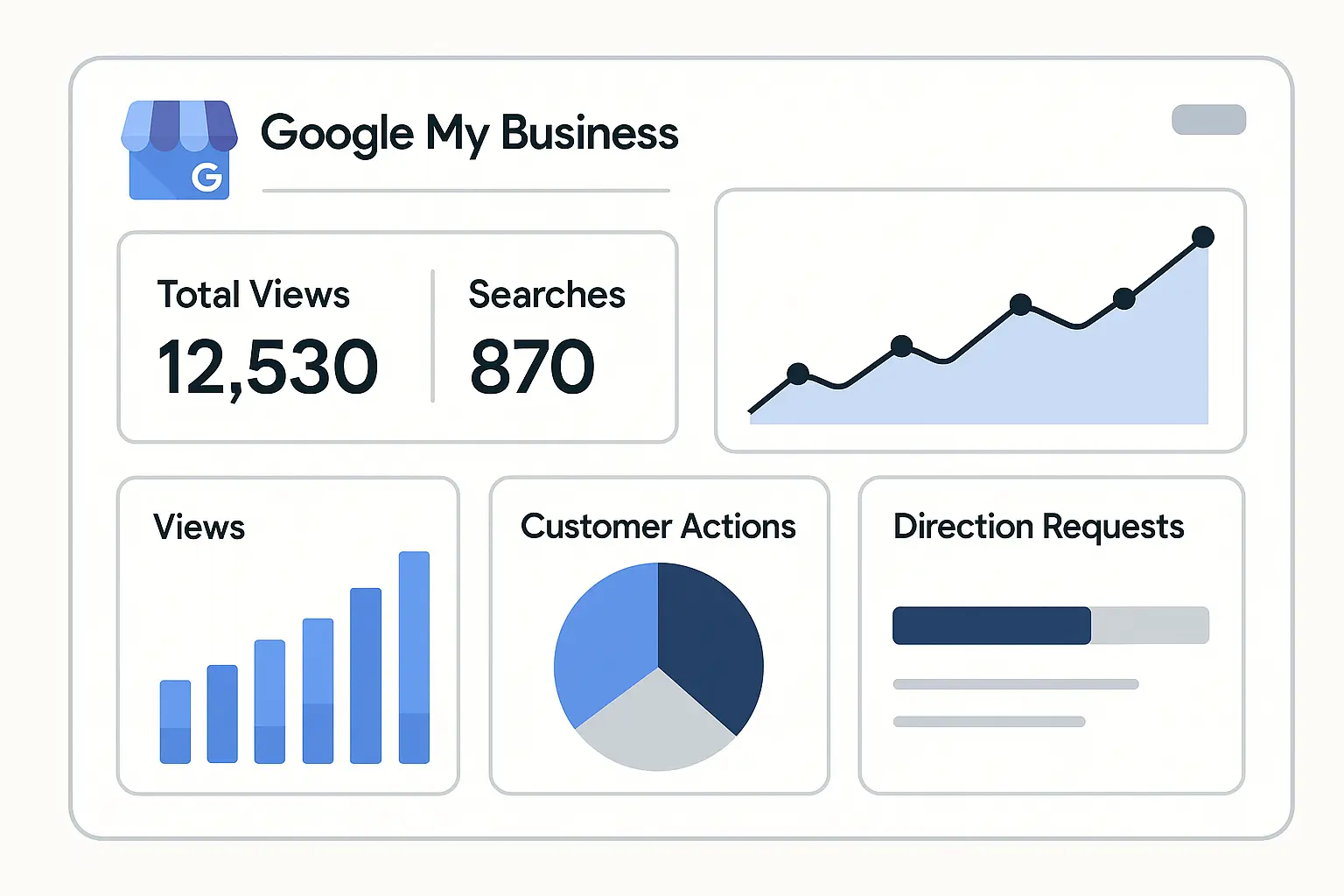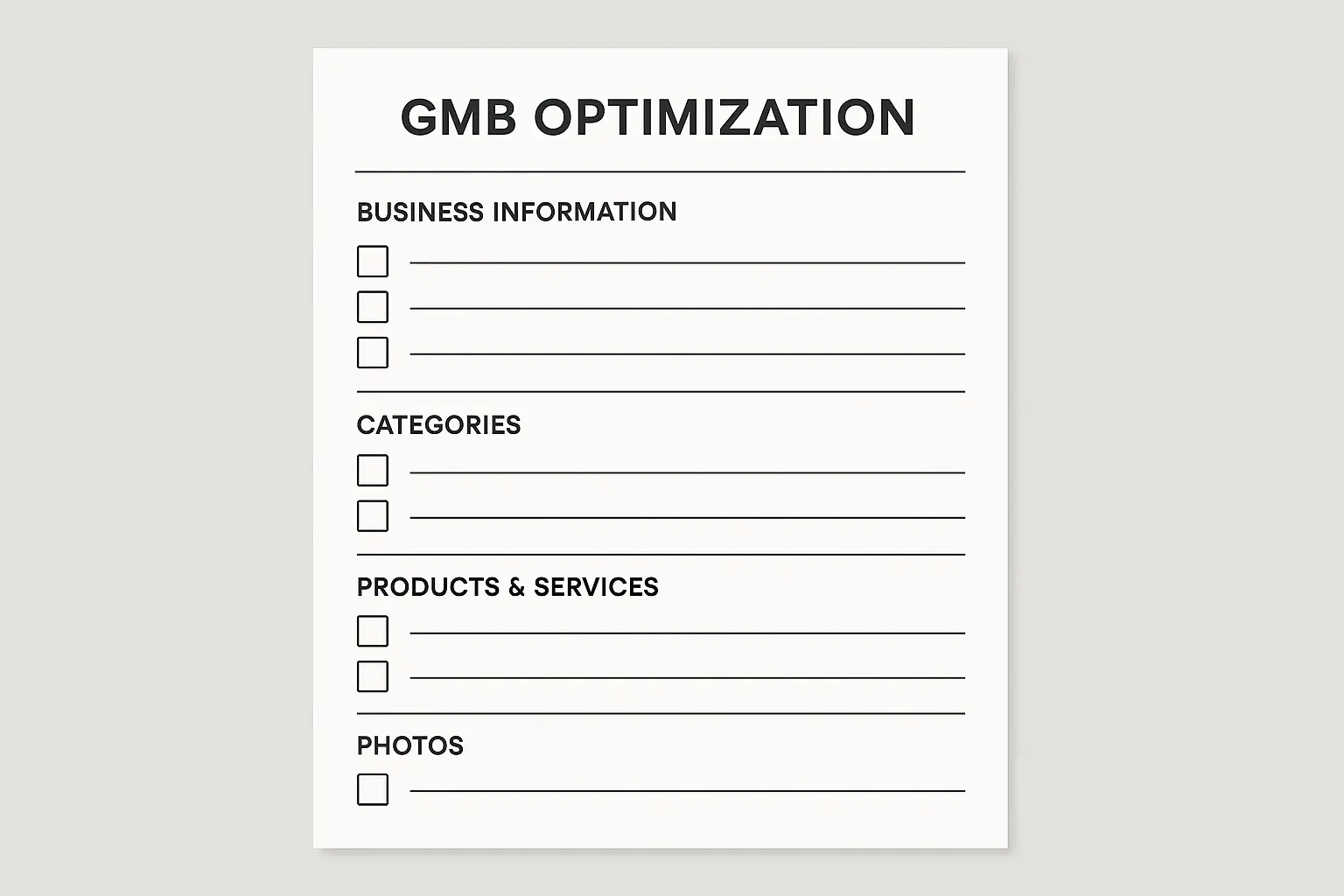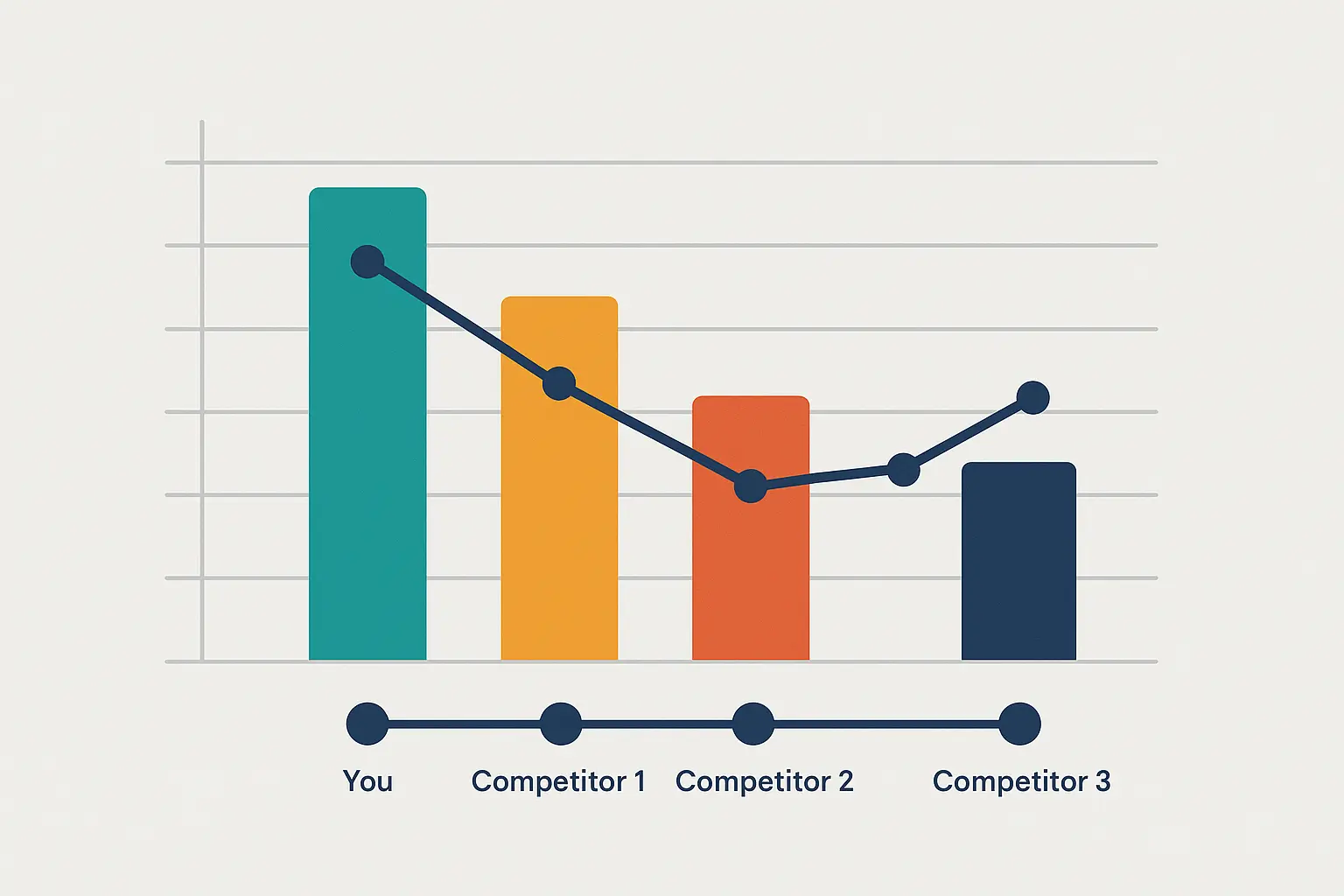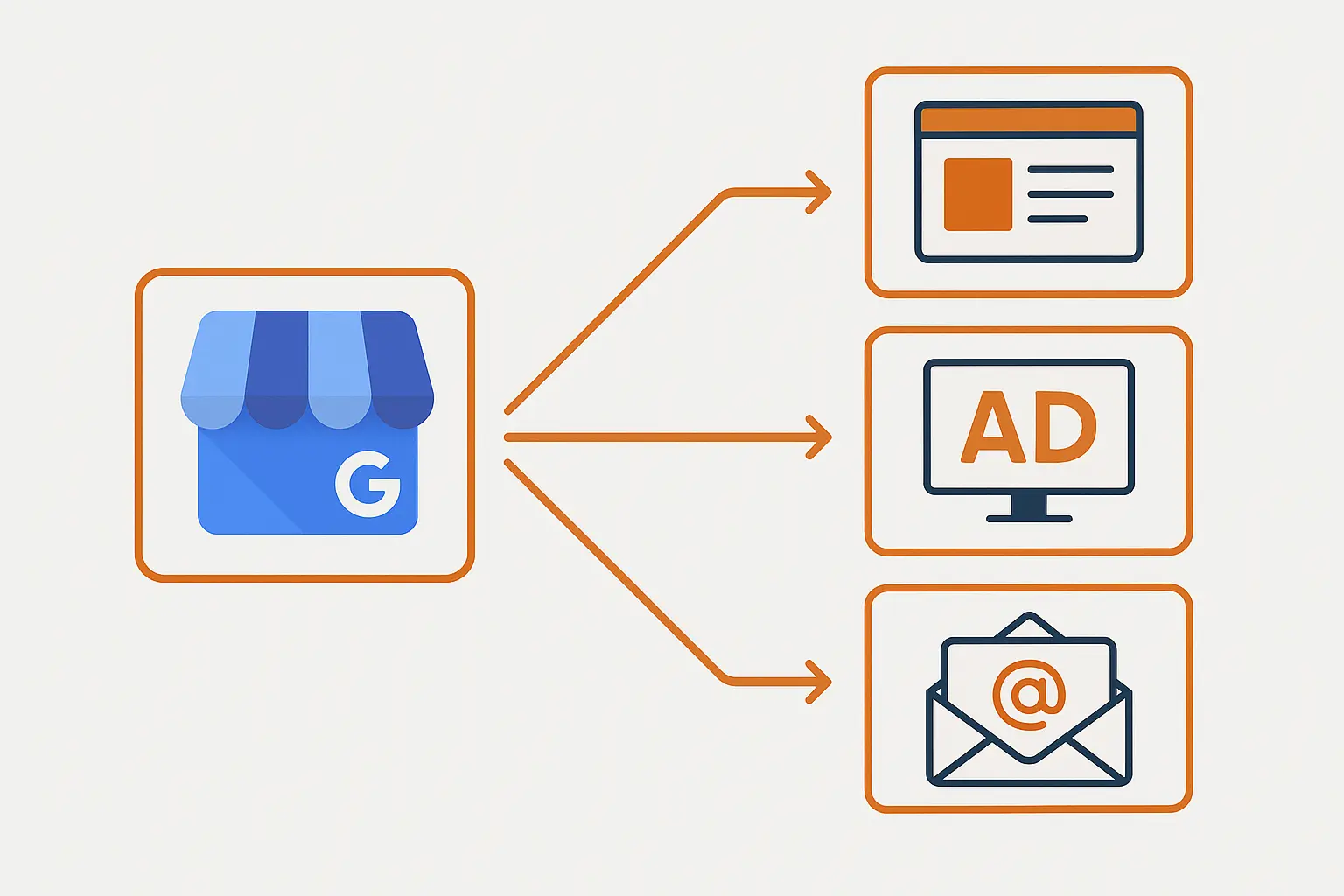I’ll be honest – when I first started analyzing Google My Business profiles, I had no idea what I was doing. I’d make random changes, hope for the best, and wonder why some businesses took off while others barely moved the needle. Sound familiar?
Local search has absolutely exploded lately. According to “Near Me” search queries have surged by more than 200% in recent years, making GMB optimization more important than ever for local businesses trying to capture this growing search volume.

Table of Contents
- Understanding the Foundation of GMB Case Studies
- Building Your Research and Implementation Strategy
- Measuring Success and Refining Your Approach
- Connecting GMB Results to Your Bigger Marketing Picture
TL;DR
- GMB case studies need you to know where you started, track what you changed, and measure what actually happened – otherwise you’re just guessing
- The tactics that consistently work: complete profiles, regular posting, and actually responding to reviews (shocking, I know)
- Different industries need different approaches – what works for restaurants fails miserably for healthcare providers
- You need both hard numbers from GMB Insights AND real customer feedback to understand what’s really happening
- Change one thing at a time so you can actually tell what’s working instead of playing optimization roulette
- Track phone calls and website visits with unique numbers and UTM codes – this is how you prove GMB actually brings in money
- Success requires ongoing maintenance, not a “set it and forget it” mentality
- GMB works best when it plays nice with your other marketing efforts, not as some isolated side project
Understanding the Foundation of GMB Case Studies
After diving deep into dozens of Google My Business transformations, I’ve discovered that most case studies are basically useless. They show you pretty before-and-after screenshots but skip the game plan that actually produces reliable insights.
Look, if you want to actually learn from your GMB efforts instead of just crossing your fingers and hoping, you need to do three things: figure out where you’re starting from, keep track of what you change, and measure what actually happens afterward. Without these foundations, you’re just throwing darts in the dark.
Breaking Down What Makes a Case Study Actually Useful
Effective GMB case studies go way beyond surface-level improvements. They need solid documentation that captures the complete picture of what changed and why those changes mattered for your bottom line.
The businesses I’ve worked with that achieved the most dramatic improvements all followed similar patterns. They measured everything before making changes, tracked every modification during implementation, and monitored results with precision afterward.
Getting Your Starting Point Right
I can’t tell you how many times I’ve worked with business owners who swore their GMB was “totally complete” only to discover they were missing half their business hours or had the wrong phone number listed for months. One client – a busy dentist – was wondering why he wasn’t getting calls, and it turns out Google was sending people to his old office location from 2019. Ouch.
You can’t measure improvement without knowing where you started, so your baseline assessment needs to capture five critical data points. First, document your current GMB profile completeness percentage – Google shows this in your dashboard, and incomplete profiles consistently get crushed by complete ones.
Second, record your existing review count and average rating because these directly impact local search rankings. Third, capture your monthly search impressions and clicks from GMB Insights. These numbers bounce around seasonally, so grab at least three months of data for context.
Fourth, note your existing photo count and engagement metrics – photos with higher view counts show you what content actually resonates with your audience. Finally, assess your current posting frequency and engagement rates. Most businesses post sporadically or not at all, missing huge opportunities to stay visible in local search results.
When establishing baseline metrics, consider leveraging comprehensive GA4 audit techniques to track GMB-driven website traffic alongside your local search performance data.
Here’s a stat that’ll blow your mind – according to research from Cube Creative Design, complete listings get clicked on up to 7 times more than half-finished ones. Yeah, I know filling out every field feels tedious, but it’s literally the difference between getting found and staying invisible.
Documenting Every Change You Make
Here’s where I see people get overwhelmed. They think they need to document everything like they’re writing a scientific paper. Relax. Just keep a simple spreadsheet with dates and what you changed. When I started, I used a basic Google Sheet with three columns: Date, What I Did, Why I Did It. That’s it.
The intervention strategy documentation becomes your roadmap for replicating success. I track five key areas whenever I’m working on GMB optimization.
Profile optimization changes include everything from updating business descriptions with relevant keywords to selecting the most accurate business categories. These seemingly small changes can make or break your search visibility.
Content posting schedules matter way more than most people realize. I track what types of posts get published, when they go live, and how frequently content appears. Here’s the truth – consistency beats perfection every single time.
Review management strategies cover both how you ask for reviews and how quickly you respond. How you handle this affects both customer perception and Google’s algorithm. Local SEO tactics integration covers citation building, making sure your business name, address, and phone number match everywhere online, and technical stuff like schema markup.
Customer engagement initiatives include special promotions, event announcements, and interactive content that gets people to actually call you or ask for directions.

GMB Optimization Documentation Checklist:
- Profile completeness percentage recorded
- Business category selections documented
- NAP consistency verified across all platforms
- Posting schedule and frequency tracked
- Review response protocols established
- Photo upload strategy planned
- Customer engagement initiatives outlined
- Local citation building progress monitored
Tracking the Numbers That Actually Matter
Most businesses track the wrong GMB metrics. Follower counts don’t pay the bills – customer actions do.
Search visibility improvements include impressions (how often your business shows up in search results), clicks (how often people actually engage with your listing), and click-through rates. If your impressions are rising but clicks aren’t, your listing shows up but doesn’t compel action.
Customer action increases are the gold mine – phone calls, direction requests, and website visits generated through your GMB profile. These actions represent real business opportunities, not just awareness.
Review acquisition rate and sentiment changes show both the volume of new reviews and their overall tone. Rapid review growth with declining sentiment suggests operational issues that GMB optimization can’t fix – you’ve got bigger problems.
Photo views and customer photo submissions show engagement levels with your visual content. User-generated photos often perform better than professional shots because they feel more authentic to potential customers.
Local ranking improvements for target keywords require tracking your position for specific search terms relevant to your business. Tools beyond GMB Insights help monitor these changes.
To maximize your ROI tracking capabilities, implement a comprehensive marketing ROI calculator that connects GMB performance improvements to actual revenue generation.
| Metric Category | Key Performance Indicators | Business Impact Level | Tracking Frequency |
|---|---|---|---|
| Search Visibility | Impressions, Clicks, CTR | High | Weekly |
| Customer Actions | Phone Calls, Directions, Website Visits | Very High | Daily |
| Review Performance | Review Count, Average Rating, Response Rate | High | Daily |
| Visual Engagement | Photo Views, Customer Photos | Medium | Monthly |
| Local Rankings | Keyword Positions, Local Pack Appearance | High | Weekly |
Spotting What Actually Works Across Different Businesses
Success patterns emerge when you analyze multiple GMB case studies, revealing tactics that consistently drive results across various industries and business types. These patterns help you focus on high-impact strategies instead of experimenting blindly with every shiny new feature.
The Optimization Tactics That Move the Needle
After analyzing dozens of successful GMB transformations, five tactics consistently show up in winning strategies.
Complete profile information with keyword-rich descriptions ranks first because Google rewards comprehensive business information. Your description should naturally include terms customers use when searching for your services, but don’t stuff it full of keywords that sound robotic.
Consistent NAP (Name, Address, Phone) across all platforms eliminates confusion for both customers and search engines. Inconsistent information across directories can absolutely tank your local search rankings.
Strategic category selection and attribute optimization help Google understand exactly what your business offers. Choose your primary category carefully – it’s the most important ranking factor you actually control.
Regular posting schedules with local event integration keep your profile active and relevant. Businesses that post weekly consistently crush those that post sporadically or not at all.
Proactive review solicitation and response management builds both quantity and quality of customer feedback. The businesses with the best review profiles actively ask satisfied customers to share their experiences and respond thoughtfully to all feedback.
Take Mike’s HVAC company. He was getting maybe 3-4 calls a month from his GMB profile during peak summer season – pathetic for an AC repair business in Phoenix. We started simple: fixed his business hours (he was showing closed on Saturdays when he actually worked), added photos of his team in action, and started posting weekly tips about AC maintenance.
Month 1: Profile completion bumped him to 8 calls. Month 2: Regular posting and review responses got him to 15 calls. Month 3: Added the Q&A section where he answered common AC questions, and boom – 23 calls. By the end of summer, he was booked solid and had to hire another technician.
How Different Industries Need Different Approaches
Generic GMB advice doesn’t work because customer expectations vary dramatically across industries. What works for restaurants fails miserably for healthcare providers.
Restaurant and hospitality businesses focus heavily on menu updates and event promotion. Customers want to see current offerings, special events, and seasonal changes. Visual content performs exceptionally well in this sector.
Healthcare providers emphasize service descriptions and appointment booking functionality. Patients need clear information about services offered, insurance accepted, and how to schedule visits. Trust signals become crucial.
Retail businesses integrate product showcases and inventory updates. Customers want to see what’s available before visiting, especially for specialty items or seasonal merchandise.
Service-based businesses highlight before-and-after project galleries. Visual proof of work quality helps potential customers understand capabilities and build confidence in hiring decisions.
Professional services showcase team credentials and client testimonials. Expertise and trustworthiness matter more than flashy visuals in these industries.

Recent developments in local search optimization demonstrate the growing importance of industry-specific strategies. According to Hospitality Net, “Over eight months, we implemented a strategic SEO optimization plan to help a hotel enhance its online visibility and drive organic search traffic for improved direct bookings. By focusing on technical audits, keyword strategy, on-page optimization, backlink development, and GBP/Google Maps revisions and citations, we transformed the hotel’s online presence and significantly increased organic traffic.” This case study highlights how hospitality businesses require specialized approaches that integrate GMB optimization with broader digital marketing strategies.
Building Your Research and Implementation Strategy
Creating a systematic approach to GMB case studies requires more than good intentions. You need structured data collection methods, phased implementation strategies, and documentation standards that actually help you learn from your efforts instead of just creating busy work.
The businesses that achieve the most reliable results treat their GMB optimization efforts with the same rigor they’d apply to any other business investment. They measure inputs, track processes, and analyze outcomes with precision.
Setting Up Your Data Collection the Right Way
Solid GMB case study analysis requires combining hard metrics from analytics platforms with softer insights from customer feedback and competitive observation. Getting your research design right from the start determines whether you’ll have actionable insights or just a confusing pile of numbers.
Getting the Numbers You Can Actually Use
GMB Insights gives you basic data, but it’s not nearly enough for serious case study analysis. You need deeper tracking systems that actually tell you what’s happening.
Setting up automated GMB Insights data extraction prevents you from losing historical data when Google decides to update its interface (which happens constantly). Third-party tools can pull this data regularly and store it in spreadsheets or databases for long-term analysis.
Google Analytics goal tracking for GMB traffic requires UTM parameters on any links in your GMB profile. Without this setup, you can’t distinguish GMB visitors from other traffic sources in your analytics – they all just look like “direct” traffic.
If people call your business (and let’s face it, most local businesses live and die by phone calls), you need to know which calls came from your GMB profile. The easiest way? Get a separate phone number just for your GMB listing. Yeah, it costs a few bucks a month, but now you’ll know exactly how many calls your optimization work is generating.
Review monitoring and sentiment analysis tools track not just review quantity but also the emotional tone of customer feedback. This data helps you understand whether operational changes need to accompany your GMB improvements.
Competitor benchmarking data collection systems monitor how your improvements compare to other businesses in your market. You might be improving while still falling behind competitors who are optimizing faster.
For comprehensive performance tracking, consider implementing advanced analytics strategies for strategic growth that connect GMB data with broader business intelligence systems.
Research from Cube Creative Design shows that businesses with 200 or more reviews have twice as much revenue as others, while the average local business has 39 Google reviews. This data underscores the importance of implementing robust review monitoring systems that track both quantity and quality metrics over time.
Understanding What the Numbers Don’t Tell You
Numbers tell you what happened, but qualitative research explains why it happened. You need both perspectives for complete case study analysis, not just spreadsheets full of data.
Customer feedback surveys about discovery methods reveal how people actually find your business versus how you think they find you. Many businesses assume customers use specific search terms that don’t match reality at all.
Staff interviews about inquiry source patterns provide ground-level insights into customer behavior changes. Your front-line employees often notice trends before they show up in analytics data.
Competitor analysis of GMB strategy approaches helps you understand market dynamics and identify opportunities others are missing. Sometimes your improvements get overshadowed by competitor advances you didn’t even know were happening.
Industry expert evaluation of profile optimization offers outside perspectives on your strategy choices. Fresh eyes often spot optimization opportunities you’ve completely overlooked.
User experience testing of GMB profile elements reveals friction points in your customer journey. What seems crystal clear to you might confuse the hell out of potential customers.

Rolling Out Changes That You Can Actually Measure
Strategic implementation requires a phased approach that allows you to isolate the impact of individual optimization tactics. This systematic rollout, combined with proper team coordination, ensures your case study results are reliable and replicable.
Breaking Down Implementation Into Phases
I know what you’re thinking – “Can’t I just fix everything at once and be done with it?” Trust me, I tried that approach for years. It doesn’t work. You’ll have no idea what actually moved the needle, and when things inevitably change (because Google loves updating stuff), you won’t know what to adjust.
Implementing everything at once creates a measurement nightmare. You’ll never know which changes drove your results.
Phase 1 (Weeks 1-2) focuses on complete profile information and basic optimization. This foundation work includes updating all business details, selecting optimal categories, and ensuring your business name, address, and phone number match everywhere online.
Phase 2 (Weeks 3-6) introduces content posting schedules and review management implementation. Regular posting begins, and you start actively asking for and responding to customer reviews.
Phase 3 (Weeks 7-10) activates advanced features and customer engagement initiatives. This might include GMB messaging, Q&A management, and special promotion announcements.
Phase 4 (Weeks 11-12) involves performance analysis and strategy refinement based on data collected during previous phases. You’ll identify what’s working best and double down on those tactics.
Each phase builds on the previous one while allowing you to measure incremental improvements. This approach provides much clearer insights than changing everything simultaneously and hoping for the best.
A dental practice I worked with followed this phased approach and saw clear attribution for each improvement. Phase 1 (profile completion) increased impressions by 23%. Phase 2 (weekly posts and review responses) added another 31% boost in clicks. Phase 3 (Q&A management and appointment booking features) drove a 45% increase in phone calls. By the end of Phase 4, they could confidently attribute a 156% overall improvement in GMB-driven appointments to specific tactics.
Getting Everyone on the Same Page
GMB optimization isn’t a solo activity. Multiple people in your organization will interact with your profile, and inconsistency kills results faster than you can say “Google algorithm update .”
Business owner or manager buy-in and training ensures leadership understands the strategy and supports consistent implementation. Without this support, optimization efforts often get derailed by competing priorities or well-meaning interference.
Staff education on review response protocols prevents well-meaning employees from responding to reviews in ways that hurt your brand. Everyone needs to understand the tone and messaging standards – you don’t want your part-time employee getting into arguments with customers online.
Marketing team integration with broader campaigns aligns your GMB content with other marketing initiatives. Conflicting messages across channels confuse customers and dilute your brand impact.
IT department coordination for website integration ensures technical elements such as schema markup and citation consistency support your GMB efforts. Technical issues can undermine even perfect GMB optimization.
Customer service team alignment with GMB messaging ensures consistent communication across all customer touchpoints. Mixed messages between your GMB profile and customer service interactions create confusion and erode trust.
Team Coordination Template:
- Owner/manager training completed
- Review response protocols documented and shared
- Marketing campaign alignment established
- IT technical requirements communicated
- Customer service messaging standardized
- Monthly team check-ins scheduled
Keeping Track of Everything That Matters
Documentation and reporting standards establish consistent methods for recording, analyzing, and presenting your GMB case study findings. These standards ensure your insights are actionable and your successes are replicable across different situations.
Building Systems That Actually Track Performance
Sporadic performance checking misses important trends and opportunities. You need systematic tracking protocols that catch problems before they become disasters.
Weekly GMB Insights data capture and analysis identifies short-term trends before they become major issues. Weekly frequency catches seasonal patterns and algorithm changes quickly enough to respond.
Monthly competitor performance benchmarking shows whether your improvements are keeping pace with market changes. You might be improving while still losing ground to competitors who are moving faster.
Quarterly customer satisfaction surveys provide broader context for your GMB performance data. Sometimes technical improvements don’t translate to better customer experiences, and you need to know that.
Ongoing review sentiment analysis and categorization helps you understand not just review volume but also the themes in customer feedback. This analysis often reveals operational issues that GMB optimization alone can’t fix.
Real-time alert systems for significant metric changes allow you to respond quickly to both problems and opportunities. Sudden drops in visibility or spikes in negative reviews require immediate attention, not monthly discovery.

Measuring Success and Refining Your Approach
This section focuses on interpreting your case study findings to identify genuine business impact and competitive advantages. I’ll show you how to connect GMB improvements to actual revenue, assess your position relative to competitors, and develop strategies that adapt to changing algorithms while maintaining long-term success.
Connecting GMB Improvements to Real Business Results
Performance impact assessment moves beyond vanity metrics to establish clear connections between your GMB optimization efforts and actual business outcomes. This analysis helps you calculate ROI and justify continued investment in local search optimization.
Proving Your GMB Work Actually Makes Money
Look, at the end of the day, you need to know if the time and money you’re spending on GMB is worth it compared to, say, Facebook ads or those expensive Yellow Pages listings your sales rep keeps calling about. It’s actually pretty simple math once you start tracking where your customers come from.
Most businesses can’t connect their GMB improvements to actual revenue. That’s a huge problem when you’re trying to justify optimization investments to skeptical business partners or budget-conscious owners.
Implementing unique phone numbers for GMB listings provides the clearest attribution path for phone-driven businesses. When someone calls the number listed on your GMB profile, you know exactly where that lead originated.
Setting up UTM parameters for GMB website traffic tracks visitors who click through to your website from your business listing. You need to know if people clicking on your GMB profile actually become customers. It’s easier than it sounds – just add a simple tracking code to your links so you can see the whole journey.
Creating customer journey mapping from GMB touchpoints reveals how local search discovery fits into your broader sales process. Some customers might discover you through GMB but convert through other channels later – you need to account for that.
Establishing lifetime value calculations for GMB-acquired customers helps you understand the long-term value of local search optimization. A customer acquired through GMB might be worth significantly more than other acquisition channels.
Developing cost-per-acquisition metrics for GMB optimization investments allows you to compare local search optimization to other marketing channels. This comparison helps you allocate marketing budgets more effectively.
To accurately measure your GMB optimization ROI, utilize a comprehensive ROAS calculator that accounts for both direct conversions and assisted conversions from local search traffic.
According to Cube Creative Design, 72% of consumers that did a local search visited a store within five miles. This statistic demonstrates the direct connection between GMB visibility and foot traffic, making it easier to calculate the revenue impact of your optimization efforts.
Understanding Where You Stand Against Competitors
Improving in isolation doesn’t guarantee competitive advantage. You need to understand how your progress compares to other businesses in your market – sometimes you’re improving while everyone else is improving faster.
Figuring out how much of the local search pie you’re actually getting compared to competitors requires tools such as BrightLocal or Whitespark to track these metrics across multiple keywords.
Review sentiment comparison with key competitors reveals whether your customer satisfaction improvements outpace the market. Sometimes your review improvements look great until you see competitors improving faster.
Seeing what cool GMB features your competitors are using that you’re not shows whether you’re taking advantage of all available opportunities. Competitors using features you’re ignoring might gain advantages you don’t even realize exist.
Local ranking position tracking for target keywords monitors your visibility for the search terms that matter most to your business. Ranking improvements for irrelevant keywords don’t drive business results.
Checking if people interact with your profile more than your competitors’ helps you understand whether your engagement levels are competitive. High engagement rates relative to competitors suggest strong local market positioning.

Adapting and Improving Your Strategy Over Time
Strategic refinement process uses your case study insights to continuously improve your GMB approach and adapt to changing local search algorithms and customer behaviors. This ongoing optimization ensures your initial improvements don’t plateau or decline over time.
Staying Ahead of Google’s Changes
Google’s local search algorithm changes constantly. Strategies that worked last year might hurt your rankings today. I’ve seen businesses that dominated local search suddenly disappear because they didn’t adapt to algorithm updates.
Monthly analysis of ranking factor correlation changes helps you identify shifts in what Google considers important for local search rankings. Tools such as Local Search Ranking Factors surveys provide industry-wide insights.
A/B testing of new GMB features and content types allows you to experiment with platform updates before committing fully. Google regularly introduces new features that might benefit your business – or completely waste your time.
Seasonal optimization strategy adjustments account for predictable changes in customer behavior throughout the year. Holiday shopping patterns, summer vacation trends, and back-to-school periods all affect local search behavior.
Local search trend integration and response planning helps you capitalize on emerging opportunities in your market. New competitors, changing customer preferences, and economic shifts all create optimization opportunities.
Platform update impact assessment and strategy pivoting ensures you respond appropriately to major GMB feature changes. Sometimes Google updates require complete strategy overhauls rather than minor adjustments.
The evolving search landscape requires constant adaptation, as highlighted in recent industry analysis. According to Backlinko, “Over 58.5% of searches now end without a click” and “for the first time, we’re seeing more impressions… and fewer clicks.” This shift emphasizes the importance of optimizing GMB profiles not just for clicks, but for visibility and brand awareness in an increasingly complex search environment where users consume information without necessarily visiting websites.
Building Systems That Scale
Single-location GMB success doesn’t automatically scale to multiple locations. You need systematic approaches for broader implementation that don’t fall apart when you try to manage more than one profile.
Multi-location profile management system implementation streamlines optimization across multiple business locations. Centralized management prevents inconsistencies that hurt individual location performance.
Standardized content creation and distribution processes ensure consistent quality across all locations while allowing for local customization. Templates and approval workflows maintain brand consistency without being overly rigid.
Centralized review management and response protocols provide consistent customer service experiences across all locations. Customers expect similar response quality regardless of which location they visit.
Performance monitoring dashboard development for multiple locations gives you visibility into comparative performance across your business network. Underperforming locations become obvious quickly.
Staff training program creation for consistent GMB management ensures all locations follow the same optimization best practices. Training materials and certification processes maintain quality standards as you scale.
| Scaling Element | Single Location | Multi-Location | Enterprise Level |
|---|---|---|---|
| Profile Management | Manual updates | Centralized dashboard | Automated workflows |
| Content Creation | Custom posts | Template-based | AI-assisted generation |
| Review Management | Individual responses | Standardized protocols | Sentiment analysis tools |
| Performance Tracking | Monthly reports | Real-time dashboards | Predictive analytics |
| Staff Training | Informal guidance | Structured programs | Certification systems |
Making Sure Your Success Lasts
Here’s the part nobody talks about – GMB optimization isn’t a “set it and forget it” thing. I’ve seen businesses nail their optimization, get great results for 6 months, then completely ignore their profile and wonder why their calls dried up. It’s like going to the gym once and expecting to stay in shape forever.
Long-term success sustainability ensures your GMB case study improvements maintain their effectiveness over time through ongoing optimization and strategic evolution. Without proper maintenance, even the best optimization efforts decay and lose their impact.
Building Maintenance Into Your Process
Most businesses optimize their GMB profile once and then ignore it. That’s exactly why their results don’t last and they end up back where they started.
Weekly content posting schedule maintenance keeps your profile active and engaging. Consistent posting signals to Google that your business is active and relevant to local searchers. Skip this for a few weeks and watch your visibility drop.
Monthly profile information accuracy audits catch changes that might hurt your performance. Business hours, phone numbers, and service offerings change over time and need regular updates. I can’t tell you how many businesses lose customers because their GMB shows they’re closed when they’re actually open.
Quarterly strategy performance reviews and adjustments ensure your optimization approach evolves with your business and market conditions. What worked initially might need serious refinement as circumstances change.
Annual competitive landscape reassessment identifies new threats and opportunities in your local market. New competitors, changing customer preferences, and economic shifts all affect your optimization strategy.
Continuous staff training on GMB best practices ensures your team maintains the knowledge and skills needed for ongoing success. Staff turnover and platform changes require regular training updates – you can’t assume people just know this stuff.
A home services company I tracked maintained 89% of their GMB performance gains over 18 months by implementing a structured maintenance protocol. They assigned specific team members to weekly posting duties, monthly profile audits, and quarterly competitive reviews. When they briefly stopped their maintenance routine for two months, they saw a 34% decline in GMB-generated leads, which recovered within six weeks of resuming their protocols.

Connecting GMB Results to Your Bigger Marketing Picture
This section explores how your Google My Business case study insights integrate with broader digital marketing initiatives to create cohesive customer experiences and amplify results across multiple channels. I’ll show you how to leverage GMB learnings to enhance SEO, social media, and reputation management while creating synergies that multiply your marketing impact.
Making Your Marketing Channels Work Together
Cross-platform synergy development leverages your GMB case study learnings to enhance performance across other digital marketing channels and create cohesive customer experiences. This integration approach multiplies the impact of your optimization efforts instead of treating GMB as some isolated side project.
Connecting GMB Success to Your SEO Strategy
GMB optimization and SEO aren’t separate strategies – they’re two parts of the same local visibility puzzle. Treating them as separate efforts is like trying to clap with one hand.
Keyword alignment between GMB content and website optimization ensures consistent messaging across all search touchpoints. The keywords you target in your GMB posts should match your website’s SEO focus – mixed messages confuse both Google and customers.
Local citation building that supports GMB authority involves creating consistent business listings across directories and platforms. These citations reinforce your GMB profile’s credibility with Google’s algorithm.
Schema markup implementation for enhanced local search features helps search engines understand your business information better. Proper schema markup can trigger rich snippets and enhanced search results that make you stand out.
Content marketing that drives both organic and local search traffic creates comprehensive search visibility. Blog posts about local topics can support both your website’s SEO and your GMB profile’s relevance.
Link building campaigns that boost local search authority involve earning links from local organizations, news outlets, and industry publications. These links benefit both your website’s domain authority and your local search rankings.
When developing comprehensive SEO strategies that complement your GMB optimization, consider utilizing proven SEO ROI calculation methods to measure the combined impact of local and organic search efforts.

Coordinating Reviews and Social Media
Your GMB profile doesn’t exist in isolation. Customers interact with your business across multiple platforms, and consistency matters more than you think.
Cross-platform content repurposing from GMB posts to social media maximizes the value of your content creation efforts. A single piece of content can serve multiple marketing channels with minor modifications – work smarter, not harder.
Unified review solicitation campaigns across Google, Facebook, and industry-specific platforms increase your overall review volume while preventing customer fatigue from multiple requests. Nobody wants to be bombarded with review requests from the same business on five different platforms.
Consistent brand messaging and visual identity across all local business listings reinforces your brand recognition and professionalism. Mixed messages across platforms confuse customers and dilute brand impact.
Social proof integration from GMB reviews into other marketing materials leverages your positive feedback across multiple touchpoints. Great reviews can enhance email campaigns, website content, and social media posts.
Customer testimonial amplification across multiple digital touchpoints maximizes the impact of positive customer feedback. A single great review can become content for multiple marketing channels if you’re strategic about it.
The Marketing Agency understands how GMB optimization fits into comprehensive digital marketing strategies. Their data-driven approach ensures your local search improvements integrate seamlessly with PPC campaigns, email marketing, and inbound marketing initiatives. Rather than treating GMB as an isolated tactic, they help businesses create synergies across all marketing channels that multiply results and maximize ROI.

Final Thoughts
Google My Business case study analysis provides a systematic approach to understanding what actually works in local search optimization, but success requires more than just following best practices you found in some blog post. The most valuable insights come from rigorous documentation, phased implementation, and continuous refinement based on real performance data rather than guesswork and wishful thinking.
Remember that GMB optimization isn’t a one-time project but an ongoing process that requires consistent attention and adaptation to changing algorithms and customer behaviors. The businesses that achieve lasting success treat their GMB profiles as integral parts of their broader marketing strategies, creating synergies across multiple channels that amplify their local search visibility and drive measurable business results.
So here’s what you should do this week: Pick ONE thing from this guide and focus on that. Don’t try to fix everything at once – you’ll burn out and learn nothing. Start with your baseline assessment, implement one change, measure the results, then move to the next improvement. Your future self (and your bank account) will thank you for taking the systematic approach instead of throwing optimization spaghetti at the wall and hoping something sticks.



